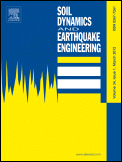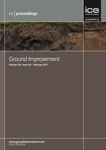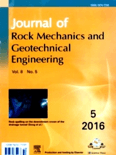
International Journal of Geotechnical Engineering
Scope & Guideline
Advancing Geotechnical Knowledge for a Sustainable Future
Introduction
Aims and Scopes
- Soil Mechanics and Behavior:
The journal emphasizes studies on the physical and mechanical properties of soils, including their behavior under various loading conditions, consolidation, and shear strength characteristics. - Foundation Engineering:
Research on different types of foundations, including shallow and deep foundations, pile behavior, and the interaction between foundations and surrounding soils, is a significant focus area. - Ground Improvement Techniques:
Innovative methods for soil stabilization and improvement, including the use of geosynthetics, chemical additives, and biotechnical solutions, are frequently explored. - Environmental Geotechnics:
The journal covers topics related to the environmental aspects of geotechnical engineering, such as waste management, soil contamination, and sustainable practices. - Numerical and Experimental Modeling:
A strong emphasis is placed on the development and application of numerical modeling techniques and experimental methods to predict soil behavior and evaluate geotechnical systems. - Geotechnical Risk Assessment:
Research addressing the probabilistic analysis and risk assessment of geotechnical designs, including slope stability and liquefaction potential, is a core theme. - Innovative Materials and Techniques:
Exploration of new materials, including recycled and sustainable materials, and their application in geotechnical engineering practices.
Trending and Emerging
- Sustainable Geotechnical Practices:
There is an increasing emphasis on sustainability, with research focusing on the use of recycled materials, eco-friendly stabilization techniques, and the environmental impact of geotechnical projects. - Data-Driven and Machine Learning Approaches:
The application of machine learning and artificial intelligence in geotechnical engineering is gaining traction, with studies aimed at enhancing predictive modeling and analysis of soil behavior. - Advanced Ground Improvement Techniques:
Innovative ground improvement methods, including the use of nanomaterials and biotechnological solutions, are increasingly being explored to enhance soil properties and mitigate risks. - Geotechnical Monitoring and Instrumentation:
There is a growing focus on the use of advanced monitoring techniques and instrumentation in geotechnical projects, allowing for real-time data acquisition and assessment of soil behavior in situ. - Risk and Reliability Analysis:
Research on probabilistic risk assessment and reliability-based design methods is on the rise, reflecting the need for more robust geotechnical solutions in uncertain conditions. - Integration of Geotechnical and Structural Engineering:
Emerging themes highlight the integration between geotechnical and structural engineering, focusing on the interaction between soil-structure systems and their performance under various loading conditions.
Declining or Waning
- Traditional Soil Testing Methods:
There appears to be a waning interest in conventional soil testing methodologies, as researchers increasingly favor innovative techniques and technologies such as machine learning and advanced numerical simulations. - Basic Slope Stability Analysis:
While slope stability remains a relevant topic, there has been a noticeable decline in publications focused solely on basic limit equilibrium methods, with a shift towards more complex, probabilistic, and numerical methods. - Purely Theoretical Models:
The journal is moving away from purely theoretical models that do not incorporate practical applications or experimental validation, reflecting a trend towards more applied research. - Generalized Soil Behavior Models:
There has been a decrease in the frequency of articles solely focused on generalized soil behavior models without specific applications or case studies, as researchers seek more context-specific insights.
Similar Journals

Journal of the Korean Geosynthetic Society
Shaping Tomorrow’s Infrastructure with Innovative GeosyntheticsJournal of the Korean Geosynthetic Society, published by the Korean Geosynthetic Society, is an essential platform dedicated to advancing the field of geosynthetics, a critical area of civil engineering and environmental science. With a focus on innovative materials and applications that contribute to sustainable infrastructure and environmental protection, this journal actively encourages submissions from researchers and practitioners worldwide. Although currently not indexed by Impact Factor systems, the journal's commitment to rigorous peer-review ensures the dissemination of high-quality research and practical insights that drive the field forward. The journal publishes a range of articles including experimental studies, theoretical analyses, and case studies, making it a valuable resource for engineers, researchers, and students alike, fostering collaboration and knowledge sharing within the geosynthetic community. The journal is accessible at http://www.kgs.org. Join us in shaping the future of geosynthetic technology through your contributions!

Soil Mechanics and Foundation Engineering
Elevating Standards in Foundation Engineering ResearchSoil Mechanics and Foundation Engineering, published by SPRINGER, is a prestigious academic journal dedicated to the dynamic fields of soil mechanics and foundation engineering. With a history spanning from 1964 to 2024, this journal serves as a vital platform for researchers, professionals, and students looking to advance their knowledge and explore innovative techniques in soil behavior, foundation design, and geotechnical engineering. Although the journal does not currently operate under an open access model, it remains essential for its contributions to key disciplines, notably in energy, geotechnical engineering, ocean engineering, soil science, and water science. Positioning itself in the third quartile of various categories in the 2023 rankings, it reflects a commitment to maintaining rigorous research standards despite its competitive environment. The unique intersection of its scope allows for multidisciplinary collaboration, making it an invaluable resource for those aiming to tackle the challenges in foundation systems and soil interactions in diverse engineering applications.

SOIL DYNAMICS AND EARTHQUAKE ENGINEERING
Innovating Solutions for Earthquake Challenges through Soil ScienceSOIL DYNAMICS AND EARTHQUAKE ENGINEERING is a premier academic journal published by ELSEVIER SCI LTD, focusing on the intersection of civil and structural engineering, geotechnical engineering, and soil science. Since its inception in 1986, the journal has established itself as a critical resource for advancing knowledge in these fields over nearly four decades, with a remarkable Q1 ranking in 2023 across multiple categories, including Civil and Structural Engineering, Geotechnical Engineering, and Soil Science. The journal’s impactful research, reflected in its high Scopus ranks, serves as a vital reference for both professionals and academics dedicated to understanding soil dynamics and mitigating earthquake hazards. Although it currently does not offer open access, the journal's rigorous peer-review process ensures that published articles provide substantial contributions to the understanding of soil behavior under seismic conditions. Whether you are a researcher, a practitioner, or a student, SOIL DYNAMICS AND EARTHQUAKE ENGINEERING offers essential insights and innovative methodologies pivotal for advancing your work in soil dynamics and earthquake engineering.

PROCEEDINGS OF THE INSTITUTION OF CIVIL ENGINEERS-GEOTECHNICAL ENGINEERING
Shaping the Future of Civil Engineering through Geotechnical InsightsPROCEEDINGS OF THE INSTITUTION OF CIVIL ENGINEERS-GEOTECHNICAL ENGINEERING, published by Emerald Group Publishing Ltd, is a prestigious journal that serves the dynamic field of geotechnical engineering and broader earth sciences. With an ISSN of 1353-2618 and an E-ISSN of 1751-8563, this journal has established itself as a vital resource for researchers, professionals, and students alike, offering insights into innovative practices and developments within the geotechnical domain. It ranks within the Q2 category for Earth and Planetary Sciences and Geotechnical Engineering as of 2023, demonstrating its significant impact and relevance in these fields. Given its comprehensive scope from 1994 to 2024, the journal provides a platform for high-quality research articles, case studies, and technical notes, although it presently does not offer open access options. Researchers seeking to publish their work will find this journal an essential venue for reaching an audience deeply invested in the advancement of geotechnical methodologies and solutions.

Periodica Polytechnica-Civil Engineering
Connecting Academia and Industry in Civil EngineeringPeriodica Polytechnica-Civil Engineering is a prestigious journal published by the Budapest University of Technology and Economics, dedicated to advancing the field of civil engineering through high-quality research and innovative practices. Established in 1972, the journal has transitioned through various phases of publication and now spans an expansive range of topics within civil and structural engineering, geotechnical engineering, and engineering geology. With an impact factor indicating its growing influence and a commendable placement in the Q3 quartile according to the latest 2023 metrics, it recognizes contributions that bridge theoretical advancements with practical applications. While currently not open access, the journal remains a vital resource for researchers, professionals, and students seeking to stay abreast of the latest developments in engineering design, construction techniques, and geotechnical innovations. The continuous publication of significant research after almost five decades underscores its commitment to disseminating knowledge crucial for the world’s infrastructure challenges, making it an essential reference point within the engineering community.

Proceedings of the Institution of Civil Engineers-Ground Improvement
Exploring the Future of Geotechnical EngineeringProceedings of the Institution of Civil Engineers-Ground Improvement is a distinguished journal published by EMERALD GROUP PUBLISHING LTD, dedicated to advancing knowledge and research in the fields of Building and Construction, Geotechnical Engineering, Mechanics of Materials, and Soil Science. With an ISSN of 1755-0750 and an E-ISSN of 1755-0769, this journal has been a vital platform for disseminating innovative research since its inception in 2008. With an impact factor placing it in the Q3 category across multiple engineering disciplines, it ranks favorably in Scopus, ensuring visibility and recognition among scholars globally. The journal offers open access options, allowing for broader dissemination of research findings. Targeting researchers, professionals, and students alike, it aims to foster discussions on ground improvement technologies and methodologies that are essential for sustainable infrastructure development. As it continues to converge its focus until 2024, the Proceedings stands as an imperative resource for those seeking to elevate their understanding and contribute to the ever-evolving field of civil engineering.

Journal of Rock Mechanics and Geotechnical Engineering
Elevating Standards in Geotechnical Engineering ResearchThe Journal of Rock Mechanics and Geotechnical Engineering is a premier open-access publication dedicated to advancing the field of geotechnical engineering and engineering geology. Published by SCIENCE PRESS and based in China, this journal has been a vital resource for researchers and professionals since it transitioned to open access in 2013. With ISSN 1674-7755 and E-ISSN 2589-0417, it has established a global reputation, evidenced by its impressive Q1 ranking in the category of Geotechnical Engineering and Engineering Geology as well as a remarkable 8th rank out of 229 in Earth and Planetary Sciences, placing it in the 96th percentile according to Scopus. The journal aims to publish high-quality research that addresses contemporary challenges in the field, offering insightful perspectives and innovative solutions. Researchers, professionals, and students are encouraged to engage with the latest findings and methodologies published within its pages, which span from 2013 to 2024 and continue to pave the way for future advancements in geotechnical practices.

Acta Geotechnica Slovenica
Transforming Earth Science Through Rigorous Research.Acta Geotechnica Slovenica is a distinguished peer-reviewed journal published by the University of Maribor, Slovenia, that focuses on the fields of geology, geophysics, and geotechnical engineering. With an ISSN of 1854-0171, it showcases significant research contributions that enhance our understanding of geotechnical challenges and innovations. The journal has been active since 2008 and has gained recognition within the academic community, holding a Q3 quartile ranking in Geology and a Q4 ranking in Geophysics and Geotechnical Engineering and Engineering Geology as per the 2023 categorization. Even though there are no Open Access options available, the journal remains an important resource for researchers, professionals, and students alike, serving as a platform for disseminating impactful findings in earth science disciplines. Its relevance is underscored by its rankings in Scopus, positioning it among the notable journals in its field. Engaging with Acta Geotechnica Slovenica offers an invaluable opportunity to stay at the forefront of geotechnical research and advancements.

Soils and Rocks
Exploring the Depths of Soil and Rock MechanicsSoils and Rocks is an academic journal dedicated to the field of Geotechnical Engineering and Engineering Geology, published by the Brazilian Association of Soil Mechanics and Geotechnical Engineering in collaboration with the Portuguese Geotechnical Society. Since becoming an Open Access platform in 2011, this journal has provided a vital publication outlet for researchers and professionals seeking to disseminate their findings on soil behavior, rock mechanics, and related topics within an international context. The journal is indexed in Scopus, holding a rank of 177 out of 229 in its category as of 2023, placing it in the 22nd percentile among its peers. Operating out of Brazil, Soils and Rocks encourages rigorous scholarly exchange and exploration of innovative practices within the sectors, making it an important resource for advancing knowledge in the geotechnical community. With a converged publication history from 2007 to 2024, the journal aims to foster significant advancements and insights that enhance our understanding of subsurface conditions and materials.

International Journal of GEOMATE
Advancing sustainable engineering practices through innovative research.The International Journal of GEOMATE, published by GEOMATE INT SOC based in Japan, is a pivotal resource for scholars and practitioners in the fields of Building and Construction, Environmental Engineering, Geotechnical Engineering, and Soil Science. Established in 2011 and continuing to set the standard in its focus areas, this journal serves as a platform for innovative research and practical applications, with contributions that significantly enhance the understanding and development of sustainable engineering practices. With its current classification in the Q3 quartile across multiple categories, it strives to disseminate critical knowledge and foster dialogue among a diverse audience, including researchers, industry professionals, and students. Though operating under a traditional subscription model, the journal's emphasis on rigorous peer review and high-quality publications ensures a substantial impact factor, further reinforcing its reputation in academia. Spanning from 2011 to 2024, the International Journal of GEOMATE invites contributions that advance the knowledge frontier and address contemporary challenges in engineering and environmental science.